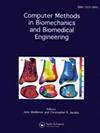使用机器学习方法诊断腕管综合征。
IF 1.6
4区 医学
Q3 COMPUTER SCIENCE, INTERDISCIPLINARY APPLICATIONS
Computer Methods in Biomechanics and Biomedical Engineering
Pub Date : 2024-10-28
DOI:10.1080/10255842.2024.2417200
引用次数: 0
摘要
腕管综合征(CTS)是一种通过体格检查和肌电图(EMG)数据进行诊断的常见疾病。本研究旨在利用机器学习技术对 CTS 的严重程度进行分类。154 名患者的肌电图数据(包括运动和感觉潜伏期、速度和振幅的测量值)被用于形成一个六维特征空间。应用了 DT、LDA、NB、SVM、k-NN 和 ANN 等分类器,并使用方差分析、MRMR、Relieff 和 PCA 缩减了特征空间。采用方差分析特征选择的 DT 分类器在完整特征空间和缩小特征空间中都表现最佳。本文章由计算机程序翻译,如有差异,请以英文原文为准。
Use of machine learning methods in diagnosis of carpal tunnel syndrome.
Carpal tunnel syndrome (CTS) is a common condition diagnosed using physical exams and electromyography (EMG) data. This study aimed to classify CTS severity using machine learning techniques. EMG data from 154 patients, including measurements of motor and sensory latency, velocity, and amplitude, were used to form a six-dimensional feature space. Classifiers such as DT, LDA, NB, SVM, k-NN, and ANN were applied, and the feature space was reduced using ANOVA, MRMR, Relieff, and PCA. The DT classifier with ANOVA feature selection showed the best performance for both full and reduced feature spaces.
求助全文
通过发布文献求助,成功后即可免费获取论文全文。
去求助
来源期刊
CiteScore
4.10
自引率
6.20%
发文量
179
审稿时长
4-8 weeks
期刊介绍:
The primary aims of Computer Methods in Biomechanics and Biomedical Engineering are to provide a means of communicating the advances being made in the areas of biomechanics and biomedical engineering and to stimulate interest in the continually emerging computer based technologies which are being applied in these multidisciplinary subjects. Computer Methods in Biomechanics and Biomedical Engineering will also provide a focus for the importance of integrating the disciplines of engineering with medical technology and clinical expertise. Such integration will have a major impact on health care in the future.

 求助内容:
求助内容: 应助结果提醒方式:
应助结果提醒方式:


